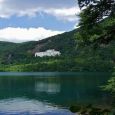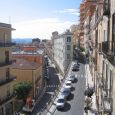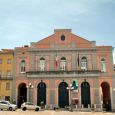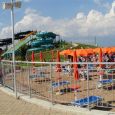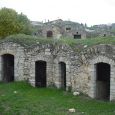Potenza
Advertisement
By Air
The city has no power of its own airport in its territory but can be served by five airports.Salerno-Amalfi coast about 85 km, (accessible by free shuttle service).Foggia-Gino Lisa about 101 km;Bari-Palese circa 130 km;Naples-Capodichino airport about 155 km.For the Airport of Basilicata are planned works are completed in order to allow development of civilian traffic on a large scale.
By Train
Potenza is a rail junction on the main line from Salerno to Taranto managed by FS Trenitalia; it has also a connection to Altamura served by the Ferrovie Appulo Lucane regional company.The city's main station which was originally named Potenza Inferiore is now known as Potenza Centrale.
By Bus
Given the location of the city it was necessary to provide citizens with a service that would allow them to not have to use cars for travel so we created several lines of escalators that connect the neighborhoods in the valley to the historic center and bus lines serving most of the urban and suburban.The town of Power at the opening of the escalators and the bridge of Via Armellini Equipped will implement the limited traffic zone (ZTL) in the whole area of the center for the whole day so as to eliminate 'high rate of passing cars in different lanes of the center and implement a program of re-evaluation of the historical center starting from the redevelopment of the main Piazza Mario Pagano.
By Road
The city has two power arteries that serve as the city bypass.The first, in the last kilometers of the Ring Power - Sicignano, and the second ring road called the North of power that connects the city to Foggia-Potenza-Melfi, starting from the hospital area of Macchia Romana, to the area of Tiera. The projects develop other two arteries: the North ring road stretch - Dragonara, Dragonara and stroke - South highway, in order to create a true ring road, to eliminate the problems related to traffic in the city.
Poggio Tre Galli
The Exhibition of United Europe, more commonly known by the inhabitants with its original name of Poggio Tre Galli is a densely populated neighborhood in the suburbs west of Power.In 2008 the inhabitants are 5,777, making it one of the most populous city, it is home to the business center of the region, in fact, is home to the palace of the Regional Council, Regional Council and other regional offices.It is also defined-City Study, possessing different high schools, a Comprehensive School and a Nursery School. Municipal organization, falls in United Europe Committee XIII.The Park of the United Europe is a newly built garden created by the City recovering a wide green area between the buildings in the neighborhood for years left to decay and all incuria.The second week of September every year, we celebrate the feast of the district, more commonly known as Sports Day, to focus more on youth and sport, with tournaments for football, volleyball, basketball and other sports.The party continues at night with concerts and live performances, finishing the last evening with a singer or a group of more fame.
May Potenza
The May Potentino identifies a series of events that the City of organizing power in conjunction with the festivities in honor of the city's patron saint, San Gerardo.It is characterized by a month and even more events, cultural exhibitions, special events of varying scope.Every year, on 29 and 30 May the city is preparing the feast. The 29 features the classic Parade of the Turks, parade in costumes that reflect the tradition of the city, followed by the Palio dei Cavalli, Alfredo Viviani Stadium.While 30 is the day in which we honor the patron saint, San Gerardo.
Turkish Parade
Every May 29 is held in power representation called "Parade of the Turks". The town dates back to the vulgate allegorical representation of the alleged invasion of May 29 to power by a turkish army, which would Basento up the river to the capital. The citizens, helpless before the invaders' military organization, it would turn to the bishop, Gerardo La Porta, and these, by invoking a host of angels warriors, would perform the miracle of liberating the city from its enemies. However, it seems unlikely that in geologically recent times, the river was navigable Basento, also not found historically traced back to the Turkish invasion of S. Gerard's Gate. It is more credible, however, that Gerard's Gate, former bishop of Piacenza, he began to be venerated as the patron saint of the city (the previous was the protector Saint Oronzio, martyr), after having been sent by the Holy See to counter the spread of 'Cathar heresy. In fact, it is certain that the Cathars, in the early decades of the twelfth century, to extend the last layers in southern Italy (although the bigger communities and across the Alps in northern Italy).
National Archaeological Museum of Basilicata
is a museum archaeological opened in 2005 to power in the renovated Palazzo Loffredo.The museum offers an overview of the archaeological finds of the region of Basilicata and a further study on the early history of the territory of Potenza.The exhibition is divided on two floors and follows a chronological and geographical.The Museum is housed in Palazzo Loffredo, built by the family of Che Guevara, the feudal lords of the city, between the late fifteenth and early sixteenth century and passed to the family Loffredo in 1604.In the nineteenth century, it housed government offices of the Internal Basilicata and was then transformed in 1825 when the "Real College" run by the Jesuits between 1850 and 1860.After the unity of Italy was the site of high school and the "Conservatory of Music" entitled to " Gesualdo da Venosa." Owned by the town of Potenza, in use has been transferred to the Superintendence for Archaeological Heritage of Basilicata for the National Museum.
Francesco Stabile Theatre
is a theater dedicated to the musician the main Potenza Francesco Stabile (1802 - 1861), located in the historic center of the city of Potenza.Built in the image of the Teatro San Carlo of Naples , was started in 1857 through the work of a group of private citizens who bought the block and they demolished. The construction was entrusted to the architects of the Theater Errico Alvino and Joseph Pisanti.The auditorium , three tiers of boxes and a gallery frame the stage and ' orchestra , fairly small in size and harmonics.The inauguration took place on 26 January 1881, in the presence of King Umberto I , Prince Amedeo, and Queen of Italy, who attended the performance of La Traviata by Giuseppe Verdi.Following the earthquake of 1980 the theater was a lot of damage, but was restored keeping the decoration of Louis Cangiano and many others. The stage in spruce maintained its central platform in Poplar, one of the few remaining in Italian theaters.
April - July
October - February


